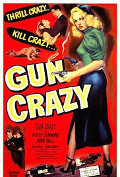
USA 1949
Directed by
Joseph H. Lewis
86 minutes
Rated PG
Reviewed by
Bernard Hemingway


Gun Crazy
Joseph H. Lewis’s black and white rendering of a Bonnie-and-Clyde-inspired story set in the post-war era is a grittily economical film featuring striking cinematography by Russell Harlan (his C.V. includes the Howard Hawks classic Red River and To Kill A Mockingbird) and a taut, psychologically well-articulated screenplay by Mackinley Kantor (bearding for the black-listed Dalton Trumbo) and Millard Kauffman based on a Saturday Evening Post story by Kantor.
Mixing elements of the “social conscience" film with film noir it tells the story of Barton (John Dall) , a mixed-up orphaned kid with a fascination for guns who is raised by his older sister, gets sent to reform school after stealing a hand-gun then does a stint in the army and returns to his hometown where he falls for an Annie Oakley-style carnival sharpshooter, Laurie (Peggy Cummins). She’s mixed-up too but she’s also got a hard streak and before long, out of money, they commence a crime spree that we (and they in their hearts) know must end up badly. Offsetting the mayhem that the two become entangled in is Barton’s essentially good nature which causes him no end of moral self-flagellation, a weakness to which Laurie is little given representing a conflict that will have an important role to play in their story.
Lewis does an excellent job of capturing the pathos of the pair’s story, mixing libidinal energy with a kind of delusional naiveté as they gradually work their way to the final deadly conclusion. Dall is perhaps a little too sweet-natured to be a likely match for Laurie’s hard-as-nails character but Cummins is excellent in the latter department delivering just the force of character to take Barton on the highway to Hell in what both come to realize is a fatally-doomed relationship. There are some things out of which you can't just shoot your way.
Harlan’s visual compositions contribute strongly to the immediacy of Lewis’s direction, shooting from under the dashboard or from a camera positioned at the rear of the getaway car bringing us right up close to the action which is shot with an unusually high degree of realism. To add texture to the fatalistic mood Lewis even manages to stage a cabaret number “Mad About You” by the film’s composer, Victor Young, with Ned Washington.
B grades don’t come much better than this.
Want something different?





